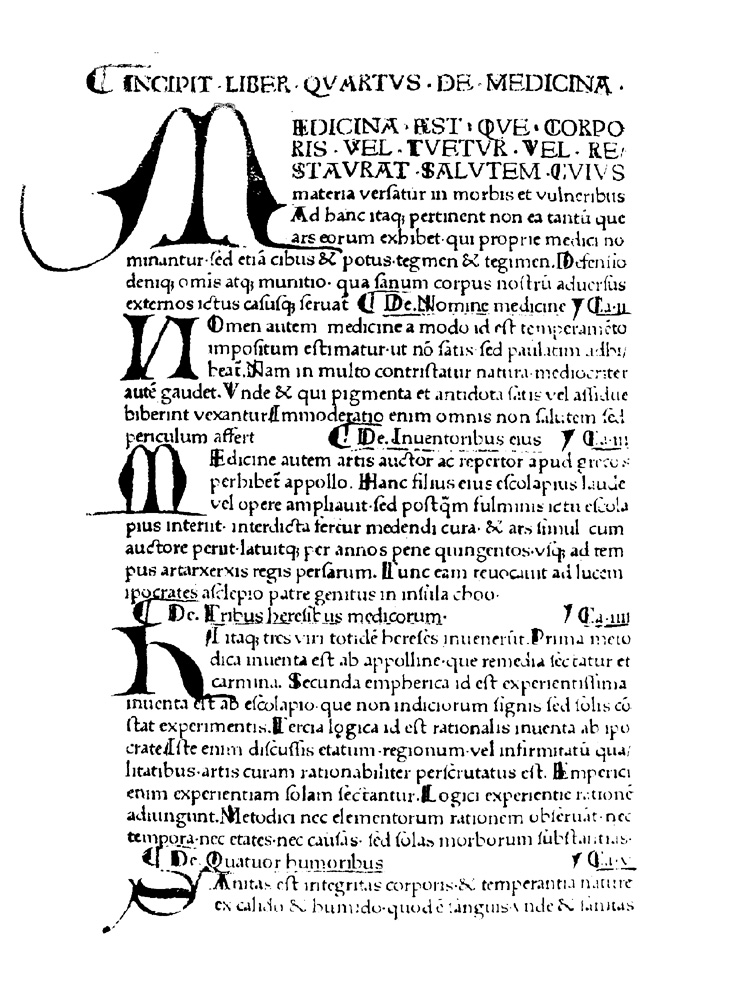ISIDORUS HISPALENSIS.
(0570? – 636)
Isidore, Bishop of Seville, became, thanks to his remarkable Etymologies, or the Origins of Words, the chief authority of the Middle Ages, and the presence of his encyclopedia in every monastic, cathedral and college library was a main factor in perpetuating the state of knowledge and the modes of thought of the late Roman world. He was Bishop of Seville from around 600 until his death.
Biographical references: Encyclopaedia Britannica, 11th edition. • Jewish Biographical Archive: S56, 196. • Nouvelle Biographie Générale (Hoefer). • Sarton, Introduction, 1928-52: 1, 471-2. • WBI.

1. Latin, 1472 [First edition].
Etymologiæ Libri XX. [Augsburg:] Günther Zainer, 19 November 1472.
2°: 264l., 3 full-page woodcut diagrams and a woodcut map of the world. Roman type, 38 lines. Page size: 300 x 210 mm.
Edition princeps. Very rare. Isidore's book is a famous encyclopedia of medieval knowledge, and in its early editions is the first book to be printed in Roman types in Germany. Just as importantly, it also contains the earliest printed map of the world, a schematic 'T-map' with areas marked as Asia, Europe, and Africa, the whole surrounded by a circle of water, with inland waterways between the continents - that between Europe and Africa being marked as the Mediterranean. There is also an illustration of the earliest printed tree of consanguinity.
This work, the most notable of Isidore, is the standard authority upon the state of learning at the end of the 6th and beginning of the 7th century. Divided into twenty books, it "defines or discusses terms drawn from all aspects of human knowledge and is based ultimately on late Latin compendia and gloss collections. The books of greatest scientific interest deal with mathematics, astronomy, medicine, human anatomy, zoology, geography, meteorology, geology, mineralogy, botany, and agriculture...His influence in the Middle Ages and Renaissance was great, and he remains an interesting and often authoritative source for Latin lexicography, particularly in technical, scientific, and nonliterary fields." -DSB.
In terms of mineralogy, Book XVI, "De lapidibus et metallis," describes stones, minerals, and metals. This was one of the principal sources available in the Middle Ages for ideas about minerals and stones, and was compiled by Isidorus from ancient sources, the most important being Pliny.
Bibliographical references: BMC XV: 2, 317. • BMC XV: II 317 [IB 5438]. • DSB. • Goff: I-181. • Goff: I-181. • Hain, Repertorium Bibliographicum, 1826-38: 9273*. • IGI: no. 5404. • Klebs, Incunabula Scientifica, 1938: no. 536.2. • Osler, Incunabula Medica, 1923: no. 13. • PPM: Printing and the Mind of Man: 9. • Polain, Catalogue, 1932: no. 2135. • Proctor, Index, 1898-1906: no. 1532. • Schramm, Bilderschmuck der Frühdrucke, 1922-36: 2, p. 10 & 24. • Schreiber, Manuel de la Gravure, 1893-1911: no. 4266. • Smith, Rara Arithmetica, 1908: p. 8. • Stillwell, Awakening Interest in Science, 1970: no. 665. • Wellcome Catalog (Books): 1, no. 3433.
2. Latin, 1473.
Etymologiæ ... [Strassburg, Johann Mentelin, about 1473].
2°: Rare.
Bibliographical references: BMC XV: 1, 57 [IC 586]. • Goff: I-182. • Hain, Repertorium Bibliographicum, 1826-38: HC 9270*. • Klebs, Incunabula Scientifica, 1938: no. 536.1 [1472]. • Oates, Cambridge 15th Century Books, 1954: no. 89. • Osler, Incunabula Medica, 1923: no. 27. • Polain, Catalogue, 1932: no. 2133. • Proctor, Index, 1898-1906: no. 227. • Schramm, Bilderschmuck der Frühdrucke, 1922-36: 19, p. 13. • Schreiber, Manuel de la Gravure, 1893-1911: no. 4267.
3. Latin, 1478.
Etymologi ... [Cologne, Conrad Winters, de Homborch, about 1478].
2°: Rare.
Bibliographical references: Goff: I-183. • Hain, Repertorium Bibliographicum, 1826-38: HC 9271*. • Klebs, Incunabula Scientifica, 1938: no. 536.3. • Madan, Oxford Books, 1895-1931: no. 2116. • Osler, Incunabula Medica, 1923: no. 139. • Polain, Catalogue, 1932: no. 2134. • Voulliéme (Köln): no. 706.
4. Latin, 1483.
Etymologiæ. De summo bono. Venice, Peter Löslein, 1483.
2°: π4 2π1 a-h10 i12 k10 χ2 A-B10 C8; 135l.; [5], 101, [2], 28 leaves, woodcuts, diagrams, general table, map. Rare.
Bibliographical references: BMC XV: 5, 379-80 [IB 22456]. • Essling, Livres à Figures Vénitiens, 1907-14: no. 303. • Hain, Repertorium Bibliographicum, 1826-38: HC 9279* [includes H 9272*]. • Hoover Collection: no. 444. • IGI: no. 5406. • Klebs, Incunabula Scientifica, 1938: no. 536.4. • Polain, Catalogue, 1932: no. 2136. • Proctor, Index, 1898-1906: no. 4904. • Sander, Livre à Figures Italien, 1941: no. 3526. • Wellcome Catalog (Books): 1, no. 3434.
5. Latin, 1489 [8 August].
Etymologæ ... Basel, [Michael Furter?], 8 August 1489.
2°: Rare.
Bibliographical references: BMC XV: 3, 787 [IB 37841]. • Goff: I-185. • Hain, Repertorium Bibliographicum, 1826-38: HC 9274*. • Klebs, Incunabula Scientifica, 1938: no. 536.5. • Polain, Catalogue, 1932: no. 2137. • Proctor, Index, 1898-1906: no. 7480.
6. Latin, 1493 [11 December].
Etymologiæ ... Venice, Bonetus Locatellus, for Octavianus Scotus, 11 December 1493.
2°: Rare.
Bibliographical references: BMC XV: 5, 442 [IB 22898]. • Goff: I-186. • Hain, Repertorium Bibliographicum, 1826-38: H 9280*. • IGI: no. 5407. • Klebs, Incunabula Scientifica, 1938: no. 536.6. • Polain, Catalogue, 1932: no. 2138. • Proctor, Index, 1898-1906: no. 5049. • Sander, Livre à Figures Italien, 1941: no. 3527.
7. Latin, 1499 [25 May].
Etymologiæ ... Paris, Georg Wolf and Thielman Kerver, for Jean Petit, 25 May 1499.
2°: Rare.
Bibliographical references: BMC XV: 8, 216 [IB 40961; variant edition]. • Goff: I-187. • Hain, Repertorium Bibliographicum, 1826-38: HC 9275*. • IGI: no. 5408. • Klebs, Incunabula Scientifica, 1938: no. 536.7. • Oates, Cambridge 15th Century Books, 1954: no. 3153. • Polain, Catalogue, 1932: no. 2139. • Proctor, Index, 1898-1906: no. 8383.
8. Latin, 1500.
Etymologiæ ... [Venice, Bonetus Locatellus, for Octavianus Scotus, after 1500].
2°: Rare.
Bibliographical references: Goff: I-188. • Hain, Repertorium Bibliographicum, 1826-38: HC 9277* [1485]. • IGI: 3, p. 184 [16th c.]. • Klebs, Incunabula Scientifica, 1938: no. 536.8 [after 1500]. • Proctor, Index, 1898-1906: p. 815 [16th c.].
.